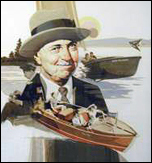 The National Marine Manufacturers Association Hall of Fame was established in 1988 to recognize and honor individuals who have made or continue to make substantial contributions toward the advancement of the marine industry. It is NMMA’s most prestigious recognition.
The National Marine Manufacturers Association Hall of Fame was established in 1988 to recognize and honor individuals who have made or continue to make substantial contributions toward the advancement of the marine industry. It is NMMA’s most prestigious recognition.
HALL OF FAME NOMINATION CRITERIA
To be eligible for the NMMA Hall of Fame Award a candidate must:
-
Have made a substantial and lasting impact on the industry or their particular segment
-
Are known in the industry and are beyond personal or professional reproach
-
A past (deceased/retired) or current member and supporter of NMMA
-
Actively involved in the marine industry for a minimum of ten years
NOMINATION PROCESS
Nominations are being accepted for the 2025 program through June 6, 2025. Active members in good standing with the NMMA are eligible to nominate a worthy industry leader. An official nomination form must be submitted by June 6, 2025. Supporting documents (letters of support, articles around the candidate's work in the industry, etc) that will enhance the nomination portfolio should be received digitally by the June 10, 2025.
REVIEW PROCESS
All nomination portfolios will be reveiwed by the NMMA Hall of Fame Committee after the nomination deadline. The NMMA Board of Directors will make a final vote to determine the award recipient(s). Nominators will be notified of award status August 2025.
AWARD PRESENTATION
Award recipients will be presented at IBEX during the Industry Breakfast taking place in Tampa, FL.
QUESTIONS
Contact: Rachel Harmon
Email: [email protected]
AWARD RECIPIENTS
1988: Elmer Carl Kiekhaefer, Charles Frederic Chapman, Garfield Arthur Wood, Ole Evinrude and Christopher Columbus Smith
Christopher Columbus Smith, 1861–1939
 Growing up in the riverside village of Algonac, Michigan had a great impact on Chris Smith, the man whose company, Chris-Craft, would eventually put the American family “on the water”.
Growing up in the riverside village of Algonac, Michigan had a great impact on Chris Smith, the man whose company, Chris-Craft, would eventually put the American family “on the water”.
Chris’s best friend also happened to be his older brother, Hank. The brothers Smith would fish and hunt along the banks of the St. Clair River. As teenagers, Chris and Hank began to build lake boats to rent to vacationing sportsmen.
At 23, Chris got married and began to raise a family, but he and his brother were still building boats. Only now, they were powered by naphtha-gas engines, not just oars. In fact, by 1906, Smith was launching 26-foot boats that would go 18 miles per hour!
One summer day while whittling a duck decoy (He sold hundreds of them!) near the river’s edge, he was thinking about how fast the local waterbugs could skate around on the water. Chris then told his son, Jay, “...somebody is going to build a boat like those bugs—one that will go on top of the water instead of through it.”
To convert that idea, that dream, into reality, Smith began to experiment with ways to develop a hull that would plane over the water, not through it! The trial-and-error research led to Smith’s famous “step-boats”, the forerunner of today’s hydroplanes. By 1916, “Chris’s crafts” smashed the world speedboat record with a 63.77 mph performance.
By 1929, Chris-Craft, with sales in the millions was run by son, Jay. (Chris preferred to whittle decoys and dream of ways to make boats go faster.)
Before the death of Chris in 1939, three generations of Smiths (now including Jay’s son, Harsen) were building boats. In fact, a design they pioneered (the modified deep-vee hull) is the concept which made high-speed boating smooth (like a waterbug) and safe enough for a family to enjoy. Thanks, Chris!